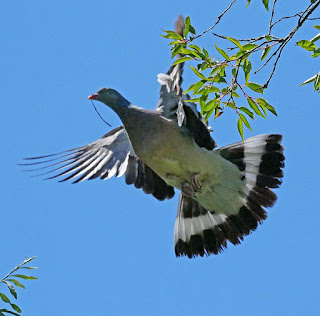I sometimes wonder whether wood pigeons are becoming a self-domesticating species. We have had resident breeders in our small garden for almost a decade and over the last five they have bred at least twice a year, so this locally adapted population hasn't had much experience of the big, wide world beyond the row of suburban gardens around us.
They behave quite differently from the wood pigeons on farmland just a mile away, where they are very wary birds. Here in the garden they walk up and down the garden path, ignoring us while we garden, and will only flutter out of the way when we come within a few feet of them. They behave almost like chickens.
They do have a comfortable life here, with bird table food in winter. This one sits under the sunflower seed feeder, picking up seed dropped by visiting finches and coal tits.
This is the tree where they have bred for the last five years - a weeping pear Pyrus salicifolia in the centre of the garden.
The tree is the hub of garden bird activity, with a tangle of pendulous branches and a cool, shady dome of foliage in summer. Tree sparrows occupy the nest box and the wood pigeons have built a flimsy nest platform of twigs directly above.
The breeding season usually begins in late February, with male birds following the females up and down the garden path, fanning out their tails and performing a kind of bowing dance. After a series of half-hearted rejections a pair bond quickly forms and then they progress to this rather endearing 'billing-and-cooing' routine, with mutual grooming.
The same basic nest platform is used every time, with the female bringing some extra twigs to add a personal touch.
The weeping pear, which is about 35 years old, constantly sheds dead twigs so there is a convenient source of nest material underneath. Sometimes, walking down the garden path, I have top duck to avoid low-flying pigeons.
The nest is about six feet above our heads as we pass underneath, so the mother bird, and the squabs when the eggs hatch, just stare down at us, undisturbed, as we pass below on our way up and down the garden.
The squabs are not the prettiest of fledglings when they leave the nest, and have peculiar soft, pointed beaks, adapted to taking an avian form of mother's milk from the crop of the parent bird, a secretion that is highly nutritious, so the juvenile birds develop quickly.
Wood pigeons generally only lay two eggs in each breeding cycle, but they are assiduous parents so chick survival rates must be comparatively high. The very demanding squabs beg to be fed by putting one wing over the parent bird's back.
You can see here how the squab pushes its beak right down into the parent bird's crop to reach that strange, milky secretion.
This is a squab in late May at about three weeks after leaving the next, still partially dependent on its parent but with a beak that's developing for foraging for an independent diet.
The adult diet is mostly vegetable, feeding on leaves, buds and seeds, but in early spring the big event in the birds' dietary calendar is the ripening of ivy berries in the hedge in the front garden. The whole crop disappears over a period of a few days in April.





























































